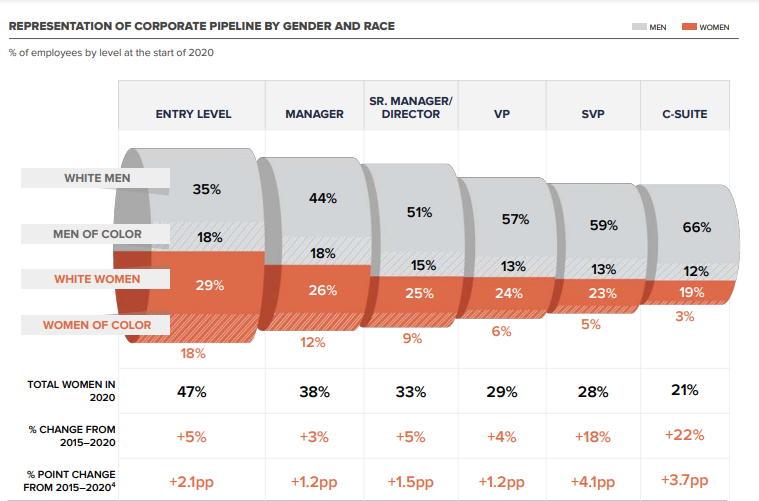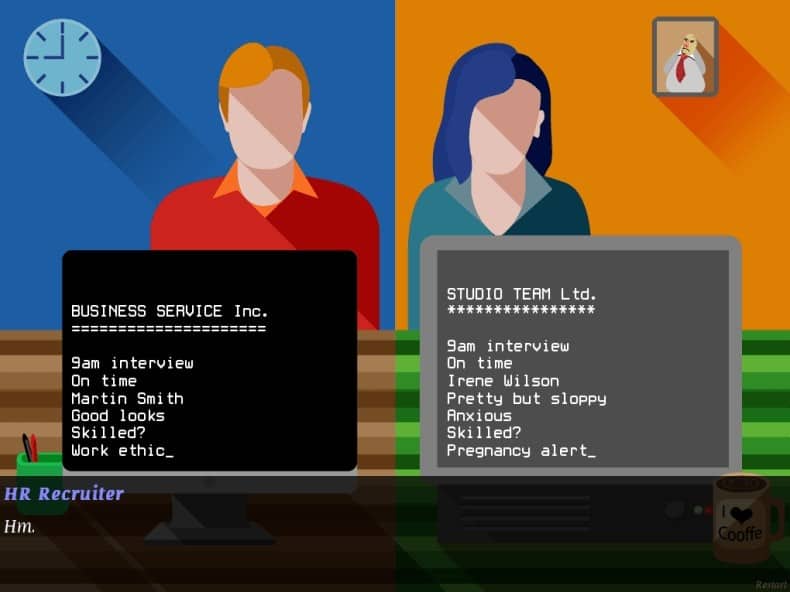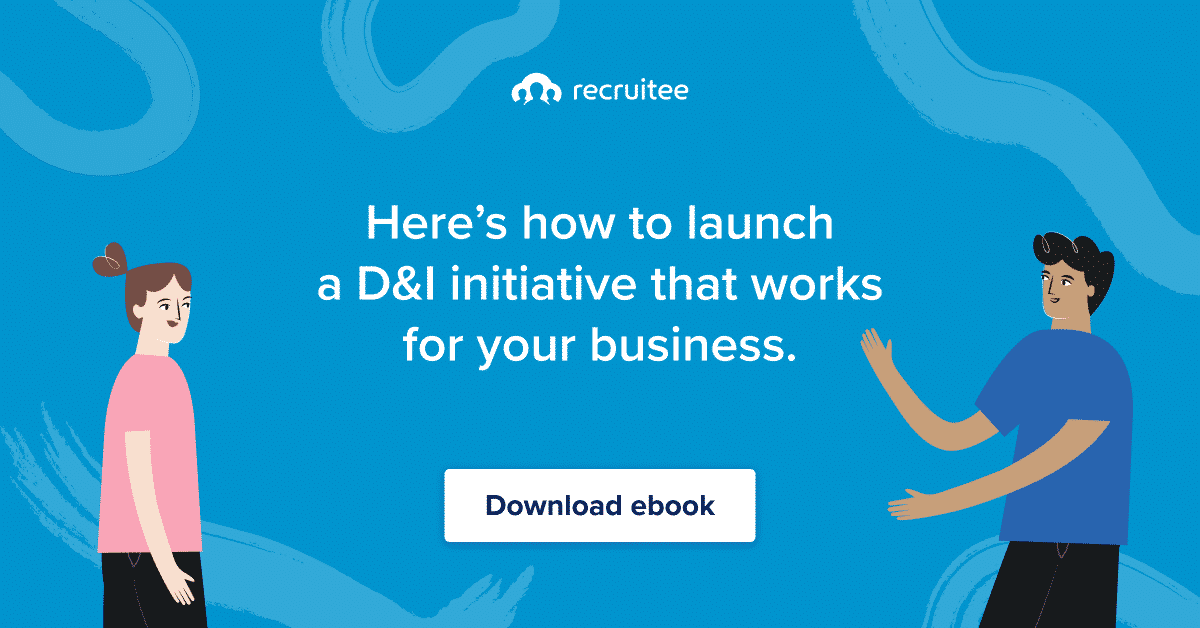The discussion of gender bias in the workplace is indelibly linked to gender roles, glass ceilings, sexism, and pay-scale differences throughout almost every industry and country. It’s a slow and long-fought battle for women holding the top roles in their organizations. It’s rarely seen as the norm, often treated as surprise contenders despite being equally as equipped for the job. Consider the following table of gender bias in the workplace statistics. It highlights one key area of a multitude of problems in an easy-to-digest format.
According to Women in the Workplace, a report in 2020, men are 30% more likely to obtain managerial roles. The results below show the percentage of employees at each level at the beginning of 2020.

As you can see, the higher up the chain, the lower the numbers fall for women in those roles. At the top level, we see men in almost 80% of the positions. On the first step of the ladder, the ratio is healthier 53:47 male vs female workers.
The definition of gender bias
Ask Google for a definition of gender bias, and this is what you’ll see:
Noun – inclination towards or prejudice against one gender.
Whether the bias is conscious or subconscious, if there’s a preference of treatment or application of attitudes and stereotypes towards one gender over another—then it’s biased.
What does that mean in plain language? Well, a prejudice is made for one sex over another, resulting in preferential treatment. It happens a lot in the workplace and is common in far too many professional settings.
When gender bias results in preferential treatment for heterosexual males, we see this as sexism. It’s not a wholly one-way street, however. In today’s society, we see a bias towards men and women, although nowhere near on the same scale.
Typical gender bias in the workplace examples
What types of gender bias are most prominent in our working lives?
- Performance support bias – when more resources, opportunities, and assistance are available for one gender over another.
- Performance review bias – evaluations align with stereotypes instead of proven performance.
- Performance reward bias – the issue of reward being delivered due to gender instead of merit. Consider bonuses, promotions, and pay-rises such elements.
The term ‘glass ceiling’ is popular amidst the debate of gender bias and sexism. Simply put, a glass ceiling delivers a metaphor for the level at which opportunity stops for a minority, whether due to sex, race, or anything else. It’s a barrier against being able to achieve the top positions in their industry, held primarily by a stereotypical type—and it’s almost always men.

The effects of gender bias
Sadly, much gender bias is unconscious. We’ve been psychologically programmed over time to see men as the more powerful and stronger sex. Over time, it’s formed how we see a normalized picture of what to expect from a working environment and gender typified roles that should no longer stand in today’s working environments.
Discrimination is toxic, and ultimately it’s delivering a negative effect on how we run and operate our businesses. The best person for the job is far too often overlooked or disregarded, and we’re shooting ourselves in the proverbial foot.
We’ve got used to seeing this as a women-only issue, but it has its impact on men too. When a man in a leadership role asks for help, they’re viewed as less competent. Or if they ask for leave in line with family duties or needs, again, they’re often judged poorly, with further negative impact.
How to avoid gender bias in the workplace
First, society needs to accept that gender bias in the workplace is real and that real work needs doing to level the playing field. The effort needs to start from the top and work its way down through the company infrastructure.
Let our leaders lead
If the working culture changes with those creating the rules and setting examples, it’s only a matter of time before it spreads through all roles and positions. Being transparent and showing that the divide has been deconstructed should be an excellent place to implement on-going change.
Equal standards in hiring and objectivity
It’s not just men who are biased when it comes to hiring; both female and male managers are twice as likely to hire a man over a woman. It’s another area of unconscious gender bias in the workplace that most won’t even notice—even if they’re fighting the cause themselves.
If we hire without bias, then we stand a better chance of seeing equality follow the same patterns throughout the workplace.
Look into your own hiring practices and see if you can’t uncover what has become standard practice for you and so many other businesses.
- Are your recruiting strategies biased? Do they primarily target men?
- Do your job descriptions include gender bias properties? Terms such as strong, decisive, or outspoken are more appealing and encouraging to men than women.
- Are interview questions standard across all genders? Or do they change according to who’s in front of your hirers? Targeted questioning is commonplace between genders.
- Are your managers biased? Hiring managers are often unconsciously biased, with underperforming candidates regularly achieving positions over better-qualified applicants.
- Is parental bias happening during interviews? Working mothers are often shown conscious and unconscious bias concerning the impact a care role could have on businesses operation and finance. So often, capable women get overlooked for the positions and salaries they deserve due to this type of discrimination.
Relevant: 6 hiring biases your team might not be aware of
Equal standards in the workplace
Once you’ve made your hires, it should be standard to follow them with gender fairness in their daily roles.
- Are mentoring opportunities equal? Can you encourage women to take on mentorship roles as well as apply for them?
- Do your pay scales and rewards systems differ between genders? The gender pay gap is commonplace between workers of matching abilities. Do your company practices need updating?
- Are perks and benefits equal across the board? Even if, on paper, all bonuses and perks are mutual, how do they translate into reality? Are you managers providing an equal distribution? Both men and women are punished for different bias due to society’s depiction of typical gender roles. If time off is family-related, men are often overlooked or looked down on for such a request. Alternatively, women can be judged as letting down colleagues and teams with any absence relating to child care.
What can you do to reduce gender bias in your business?
- Collect and analyze data regarding employee demographics. Check any differences between men and women by role, seniority, and department.
- Analyze your pay structures and how they translate across your employees.
- Live testing in your business can reveal the real facts. Anonymous surveys deliver the most accurate and honest data.
- Automate your hiring processes. AI software automatically creates the fair hires and checks you need, taking out all of the human bias we create visually or from society’s ingrained values.
- Introduce gender bias training to better recognize any existing problem areas.
- Standardize your mentoring and leadership training programs.
Gender gap frustrations highlighted by a simple recruiting game
When Mauro Vanetti delivered a simple game with a weighted outcome, the abuse he received showed just how strong its players felt about gender bias at work.
Make a game about time travel and talking lizards, nobody objects. Make a game about the gender gap, “This is unrealistic!”

The amount of hate Mauro Vanetti received for his two-minute game was insane. Mauro made “Two Interviewees” as a tiny gaming experiment with the anti-sexist theme. And the Internet exploded with haters calling him from sexist to ISIS.
“I must have struck a chord,” Mauro tweeted. Gender gap in employment has been that giant elephant in the room. Since the research into orchestras’ “blind” audition process revealing unconscious gender bias in the 1970s ’till this very moment, the problem still exists. It’s a touchy, tricky one.
In Mauro’s game, you play as two characters: Martin and Irene. Both have the same professional background, and are going to have an interview for the same company with the same “HR Recruiter” — Mr. White. They got the same questions and give the same answers. The only difference here is the shocking biased mind of the interviewer.
No matter which answers you choose, Irene won’t get hired. Many players were pissed off and wondered if they did it “right.” In two minutes, they feel the frustration that many women have to face their entire lives.
Mauro may exaggerate “Two Interviewees” to make a point, but it’s not far from the truth. At no certain stage of the hiring process would somebody say “Let’s disqualify women.” For the most part, we make decisions based on our experience, impression, hunch, and unconscious bias — the gestalt formed from the societies we live in, that sadly are in favor of the male population at large.
Our stance here is not about hiring women because of their gender. It’s about not passing on talented women just because of existing bias and implicit stereotypes.
Studies show that we form an unconscious bias against women when: 1) the number of women in an applicant pool is small, 2) evaluators are under time pressure, fatigued, or need a quick decision, and 3) when performance criteria are ambiguous.The good news is that we can prevent all three nowadays by establishing a good process, with the help of technology.
Additional reading: Tackling gender inequality in the workplace








